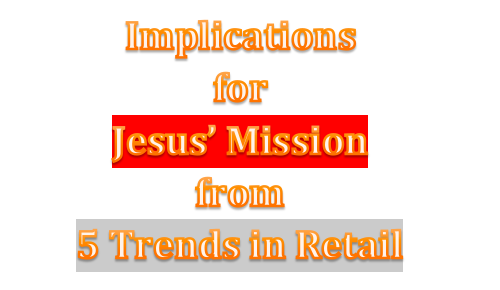
I am currently helping a large, non-profit Christian retailer go through a visioning process. Last week a retail consultant led two hours of dialogue in a meeting I attended. These points are heavily adapted from that conversation with some additional thoughts on how they relate to the church.
Trend #1: Tweets and Seats- Provide free wifi and places to sit.
This is fairly simple to apply at church. Don't wonder wether you should have wifi or not in any church space. Provide it! Retailers understand this is not a distraction for their customers but is a part of how their customers live (constant mobile connectivity). In addition, its an opportunity for customers to engage the retail space itself in deeper ways like getting more product information, validating lowest price or seeing creative applications and outcomes of certain products.
In church, the connectivity that wifi provides can translate to deeper engagement to everything that matters for the mission. Examples:
"Can I download the music I am worshipping to right now for personal worship on tuesday morning?
"Can I sign-up for a group while I am listening to a sermon on biblical community?"
"Can I use my preferred digital copy of God's word while following the sermon?"
Can I take notes in way that will be automatically accessible in a cloud before I leave the service?"
The possibilities are endless.
Trend #2: Big Data- Know my wife's birthday—and remind me—before it comes to my mind.
Big data is used to describe the massive amounts of data that retails are able to gather, configure and use to better serve their customers. As connectivity, social media and technology accelerate, big data will yield mind-numbing implications for how people are served. For example, imagine Hallmark cards reminding you of your wife's birthday at the right time, the right place in the right way (device & medium) for you.
Today at Elevation Church, every attender was strongly urged to tear off a response card and answer three questions. The first question is "What year were you born?" The big deal is the appeal that was made in the moment of asking. The creative pastor shared that, "We want to do everything possible to design the best worship experience for you and this information will help us." This is Elevation's way of building their data.
There are a few big players out there in the church information space (I recommend checking out CCB). Be sure to select the one that is most usable and relevant for the future possibilities of big data. More importantly, think creatively of the umpteen ways that you can collect and use information to serve people. For example, I was recently scolded by my church's student ministry assistant for missing the cut-off of camp sign-up. (Okay, it was my fault). But there's about 3-4 different ways that this ministry could have reminded me of this info, if they used the data they already possessed. Is a simple text reminder asking too much? Think of the implications way beyond event sign-up, like daily discipleship tools, digital missions and social story-telling. Quite frankly, the possibilities are amazing if church leaders wake up to this opportunity!
My prediction: the pastor of digital engagement will be the fastest growing new church job of the future.
Trend #3: The Back Story- Sharing why you sell what is you sell is more important than what you sell.
If you look, you will see many retailers returning to their roots and telling their creation story to emotionally connect you to their brand. Johnston & Murphy wants you to know they have been making shoes since 1850 and, it just so happens, they are the shoe provider for U.S. Presidents. While we see this all the time with creative upstarts and social entrepreneurs, more and more big for-profits are going there.
The simple lesson for the church is that values are important— a practice we are constantly trying to help church leaders advance at Auxano. This trend should be the church's constant centerpiece, at least with regard to the biblical ideal. Why we do what we do is the heart of any ministry. The relevant application of this is pushing your ability to articulate—and then integrate—how your unique creation story and ministry values help people see, experience and engage the vision. The first step is to communicate the difference. Why does your community need your church anyway? (And don't give me with generic answers.) Here is an article just posted on the Vision Room that will help.
Trend #4: Store within a store- Speak to specific segments within your tribe.
Stores like JC Penny or Best Buy are leading the way. At Best Buy you can make a purchase at several different stores within the big store. For example, you can buy standard cables for your new TV in the standard Best Buy aisles or you can go to Magnolia section, with a distinct in-store look and feel, and pickup higher-end cables. You will pay more, but you will also get customized service, like a follow-up phone call, to see how your TV installation went.
This is a harder point of application for churches, because of the pre-existing problem of fragmentation. In other words, if your church already has too much stuff, creating another sub-ministry logo won't help. (Here is a post on that challenge.) The best way to apply this principle is not with a sub-ministry program in the traditional sense, but with an equipping feature in the "tools and resources" sense. For example, Mountain Park Community Church has a "Home Team" area in their lobby with tools for families based on specific family issues and life stages. The resource center does not clutter the church's programatic offering but provides a "value-add" to certain segments of their congregation. The key question is "How can you add specific value to specific groups in your church?"
Trend #5: Generational Training- Teach a millennial how to greet a boomer.
Retailers know that age-segment values and practices can make people feel like arrived on a different planet. You can't just expect a 23 year-old woman to know how to great a 63 year old woman. Tight-niche retailers worry less about this because they will hire to mirror their demographic target.
But most churches don't have this tight-niche luxury, so this trend is particularly appropriate. When was the last time you trained your first-impressions team or welcome ministry in generational preferences? Beyond greeting, imagine the rich implication for all of discipleship. In many churches with history over 30 years, generational viewpoints on walking with God may be your greatest under-utilized asset. How are you leveraging the variety of perspectives, convictions and practices of generations for the sake of the mission?
I would love to hear of any practical applications along these line at your church!
